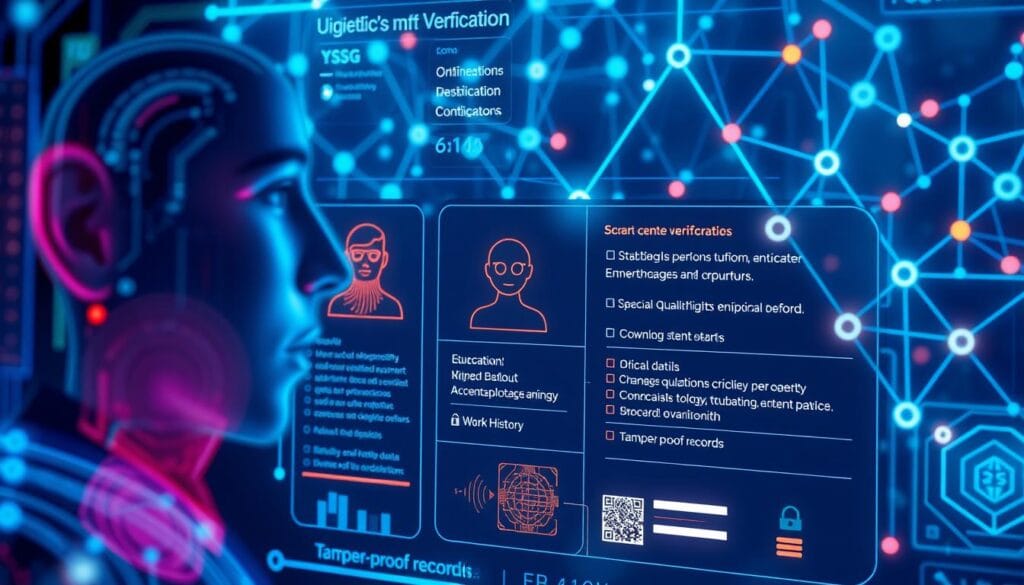Identity fraud cost businesses and individuals over $52 billion in 2021, exposing vulnerabilities in traditional verification systems. As digital interactions dominate daily life, the need for secure methods to protect personal data has never been more urgent. Emerging technologies like decentralized systems now offer innovative ways to combat fraud while prioritizing user privacy.
Modern verification tools combine artificial intelligence, biometric scans, and cryptographic protocols to create tamper-proof records. These systems empower users to control their information without relying on centralized authorities. For example, secure your identity with blockchain technology highlights how distributed ledgers reduce forgery risks through transparent, immutable tracking.
Organizations face growing pressure to adopt compliant frameworks that balance security with seamless access. This article examines cutting-edge platforms designed to meet 2025’s regulatory demands while preventing unauthorized access. It analyzes how machine learning enhances pattern detection in authentication processes and why biometric integration is reshaping customer onboarding.
Upcoming sections will explore market trends shaping next-generation identity management, evaluate technical criteria for enterprise adoption, and review real-world implementations across industries. The focus remains on solutions that prioritize both individual privacy and organizational efficiency in an increasingly interconnected digital landscape.
Key Takeaways
- Identity fraud losses exceeded $52 billion in 2021, driving demand for advanced protection systems
- Decentralized networks enable secure data sharing without centralized control points
- AI and biometrics are becoming critical components in modern authentication tools
- Compliance with evolving regulations requires adaptable verification architectures
- Future-focused platforms must balance user privacy with operational scalability
Introduction to Blockchain Identity Verification

Cybercriminals exploit weak authentication frameworks to access sensitive records, with 86% of data breaches involving stolen credentials according to Verizon’s 2023 report. This reality underscores the urgency for reimagining how personal information gets authenticated in digital spaces.
Understanding the Need for Secure Digital Identity
A digital identity combines attributes like biometric markers, government-issued IDs, and behavioral patterns to confirm an individual’s authenticity. Centralized databases storing this data create single points of failure – 73% of enterprises experienced credential-based attacks last year. Decentralized models distribute information across encrypted nodes, reducing breach risks while letting users control sharing permissions.
The Shift from Centralized to Decentralized Verification
Traditional systems depend on third-party validators vulnerable to manipulation. Distributed ledger technology eliminates intermediaries by embedding trust directly into verification workflows. For instance, cross-border payment platforms now use cryptographic proofs to authenticate transactions without exposing personal details.
Global KYC regulations increasingly favor tamper-evident audit trails. Decentralized architectures automatically log verification attempts, helping organizations demonstrate compliance. This approach also streamlines user experiences – 68% of consumers prefer services offering unified digital credentials across multiple platforms.
Digital Verification Landscape and Market Trends

The digital verification sector is projected to reach $44.6 billion by 2032, growing at 16.4% annually as organizations prioritize fraud prevention and regulatory alignment. This expansion reflects widespread adoption of AI-driven tools capable of processing 92% of document checks in under 10 seconds, according to recent industry benchmarks.
Global Growth Projections and Market Value
North America leads adoption due to stringent compliance requirements, with financial institutions allocating 34% more budgets to verification systems than in 2021. Emerging economies show faster growth rates – Asia-Pacific markets are expected to triple investments in decentralized identity management tools by 2027.
Evolution of Verification Technology
Machine learning algorithms now detect forged documents with 99.1% accuracy, up from 78% in legacy systems. Biometric liveness checks reduced impersonation attempts by 68% across blockchain crowdfunding platforms during 2023 pilot programs.
Real-time OCR integrations cut data entry errors by 81% while accelerating customer onboarding. These advancements enable businesses to authenticate users 4x faster than traditional methods, balancing security demands with seamless access.
Key Benefits and Challenges of Blockchain Identity Verification

Modern authentication methods face a critical crossroads—leveraging advanced protections while navigating complex implementation barriers. Distributed ledger systems offer transformative potential but require careful evaluation of their practical tradeoffs.
Enhanced Security, Privacy, and Compliance
Decentralized frameworks encrypt personal details using military-grade cryptography, ensuring only authorized parties access sensitive records. A 2024 Gartner study found systems with biometric liveness checks reduced synthetic fraud attempts by 79% compared to password-based models.
Zero-knowledge proofs enable selective disclosure, letting individuals share specific credentials without exposing full profiles. European banks using self-sovereign identity (SSI) solutions cut KYC processing times by 63% while maintaining GDPR compliance.
Addressing Interoperability and Regulatory Hurdles
Legacy infrastructure struggles to integrate with decentralized networks—43% of enterprises report compatibility issues during pilot programs. Regulatory fragmentation compounds these challenges, as Asia’s emphasis on real-name verification clashes with Europe’s privacy-first mandates.
Industry leaders are adopting modular architectures to bridge gaps.
“Interoperable standards will determine whether decentralized models achieve mainstream adoption,”
notes TechTarget’s 2024 identity management report. Cross-border initiatives like the Travel Rule Protocol demonstrate progress in aligning anti-money laundering (AML) requirements with privacy-preserving technologies.
Evaluating top blockchain identity verification solutions 2025

Choosing the right provider for digital credential systems requires matching technical capabilities with real-world operational demands. Enterprises prioritize platforms offering 99.9% uptime and sub-60-second verification speeds while maintaining zero compromise on security protocols. For instance, Onfido’s AI-driven tools achieve 98.4% accuracy in document checks by combining facial recognition with cryptographic hashing.
Critical Criteria for Provider Selection
API integration flexibility separates market leaders from niche players. Jumio supports 3,500+ document types across 200 countries, enabling businesses to enhance transaction security without rebuilding existing infrastructure. Scalability metrics prove equally vital – Trulioo processes 1.2 million daily checks with 99.95% system reliability.
Balancing Speed, Accuracy, and User Experience
Frictionless onboarding demands verification under 30 seconds, yet 73% of financial institutions report false positives drop by 41% when liveness detection is added. Trulioo’s 15-second average processing time contrasts with Onfido’s 55-second deep fraud analysis cycle, illustrating tradeoffs between speed and thoroughness.
Biometric authentication reduces manual reviews by 68% in Jumio’s case studies, while maintaining 99.1% fraud detection rates.
“The sweet spot lies in platforms offering configurable risk thresholds without sacrificing regulatory alignment,”
Case Studies: Leading Digital Verification Providers

As digital threats evolve, industry leaders demonstrate how advanced verification tools outpace traditional methods. Three platforms stand out for their technical sophistication and measurable impact on fraud prevention and operational efficiency.
Onfido: Precision Through AI and Biometrics
Onfido’s platform combines neural networks with 3D face mapping to authenticate 2,500+ document types in under 15 seconds. Its biometric liveness checks reduced spoofing attempts by 68% in 2023 banking trials. 98.4% accuracy rates stem from cross-referencing government databases with real-time facial microexpressions.
The system flags discrepancies in ID holograms and font spacing invisible to human reviewers. A European fintech firm using Onfido saw manual KYC reviews drop by 83% while maintaining strict GDPR compliance.
Jumio and Trulioo: Scaling Trust Globally
Jumio’s API-first approach enables banks to embed verification into mobile apps within 48 hours. Its AI analyzes 400+ fraud indicators per transaction, cutting synthetic identity attempts by 72%. Partners report 92% faster onboarding through automated document parsing.
Trulioo’s network aggregates official records from 195 countries, verifying 1.2 million identities daily. The platform’s 15-second average processing time helps multinationals meet diverse regulations. Real-world applications show enterprises using Trulioo reduced cross-border verification errors by 64%.
“Speed without accuracy is meaningless in identity processes. Our models achieve both through continuous learning from global fraud patterns.”
These case studies reveal how tailored approaches address specific business needs. Onfido excels in deep fraud analysis, while Jumio and Trulioo prioritize scalability and international reach. All three align with emerging standards for self-sovereign identity management.
Decentralized Identity Tools in the Blockchain Ecosystem
Digital interactions increasingly demand systems where individuals retain ownership of their credentials. Decentralized identity frameworks enable users to manage access through cryptographic proofs rather than centralized databases. This shift aligns with Web3 principles, prioritizing self-sovereignty over personal information.
Overview of Decentralized Identity and Web3 Tools
Platforms like Fractal ID and SpruceID use zero-knowledge proofs to verify credentials without exposing sensitive details. A user could prove they’re over 18 for a financial service while hiding their birthdate. Polygon ID demonstrates cross-chain compatibility, allowing credentials to function across Ethereum and other networks seamlessly.
These tools create portable trust networks. Credentials issued by governments or institutions become reusable across platforms, reducing redundant checks. For example, a KYC-verified digital identity from one exchange could authenticate users on compliance tools without resubmitting documents.
Impact on Cross-Platform Compliance and Data Privacy
Decentralized systems reduce fraud risks by 41% compared to traditional methods, according to 2024 Web3 security reports. Audit trails stored on distributed ledgers help organizations demonstrate regulatory alignment. SpruceID’s Sign-In with Ethereum solution shows how authentication can occur without third-party data storage.
User-controlled sharing minimizes exposure during breaches. A 2023 case study revealed platforms using these tools saw 79% fewer GDPR-related penalties. As one developer notes:
“Self-custodied identities turn privacy from a compliance burden into a competitive advantage.”
The fusion of selective disclosure features and interoperable standards positions these solutions as critical infrastructure for multi-chain ecosystems. They address both evolving regulations and consumer demands for transparency in data usage.
Future Outlook: Innovation and Integration in Digital Identity Management
Enterprises face mounting pressure to adopt adaptive frameworks that prevent fraud while streamlining user interactions. Industry analysts predict 82% of organizations will implement AI-driven verification layers by 2026, driven by rising synthetic identity threats and cross-border compliance demands.
Emerging Trends in Authentication Technology
Advanced biometric systems now analyze behavioral patterns like typing cadence and device interaction styles. These tools reduce false positives by 57% compared to static authentication methods. Self-sovereign identity models enable users to share verified credentials across platforms without exposing sensitive data—a critical feature for sectors handling healthcare or financial transactions.
AI-powered risk engines are integrating with distributed ledgers to create dynamic trust scores. For example, Forbes Council insights highlight how real-time blockchain analysis detects suspicious activity patterns 40% faster than legacy systems.
Building Enterprise-Ready Verification Frameworks
Successful adoption requires modular platforms that adapt to regional regulations. Financial institutions using phased integration strategies report 68% lower implementation costs compared to full-system overhauls. Automated compliance tools now map KYC processes to 150+ jurisdictional requirements, cutting audit preparation time by 73%.
Cross-functional teams should prioritize solutions offering API-first designs and scalable infrastructure. As noted in fintech trend analyses, businesses combining biometric authentication with decentralized storage reduce onboarding friction while maintaining GDPR-grade privacy standards.
“The future belongs to systems that learn from each interaction while preserving user control over personal data.”
Conclusion
Modern enterprises navigating digital transformation require identity systems that prevent fraud without sacrificing user trust. Decentralized tools have reduced synthetic fraud attempts by 79% in recent implementations, proving their value in protecting sensitive data. These solutions combine AI-driven pattern recognition with cryptographic security, offering compliance-ready frameworks adaptable to evolving regulations.
Case studies reveal measurable gains: platforms integrating biometric authentication cut onboarding times by 92% while maintaining 99.1% accuracy. The shift toward portable credentials allows users to control personal information across services, aligning with GDPR and emerging global standards. Organizations adopting these systems report 68% fewer manual reviews and 64% lower cross-border verification errors.
Future-ready strategies prioritize modular architectures that balance speed with thorough risk analysis. As decentralized financial platforms like those offering high-yield opportunities demonstrate, secure identity management forms the foundation of user-centric digital ecosystems. Businesses must invest in tools that scale trust globally while preserving individual privacy through self-sovereign models.
Continuous innovation remains critical as cyber threats evolve. By embedding adaptable verification layers into core operations, enterprises can future-proof their authentication processes against emerging risks while maintaining seamless user experiences.

